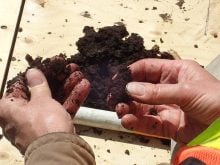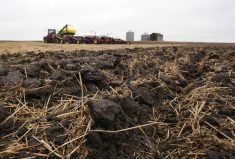What is a healthy soil? It is difficult to def ine that term so we prefer to use the term soil quality.
Soil quality can be measured in terms of organic matter, fertility, texture, salinity, cation exchange capacity, pH and a number of other factors, all of which have identifiable quantitative numbers that can be used to describe the quality of a soil.
Jared Diamond, in his bookCollapsedocuments the collapse of past societies as well as some modern ones that he claims are undergoing collapse right now.
Read Also

Still hard to predict precise fertilizer payback
Despite decades of advances, international research finds no clear answer for where and when adding nutrient will fail to boost growth.
Diamond’s view is that these societies all collapse from a common cause: the exhaustion of natural resources, one of which is the soil. In Mesopotamia, the Sumerian civilization salinized their soil, on Easter Island they cut down the last tree, reducing agricultural capability for the entire society.
David Montgomery, in his bookDirt: The Erosion of Civilizationsfocuses in on soil as being the foundational natural resource on which all societies depend. Montgomery documents in detail the relatively recent soil erosion on the Great Plains in North America.
HEALTHY SOIL NECESSARY
David Lobb, a soil scientist at the University of Manitoba has given presentations and papers documenting the greatest type of soil erosion after the dust bowl as tillage erosion.
Salinity, deforestation, soil erosion – these are all familiar problems that we know about. We have developed agricultural practices such as zero tillage and other water and crop residue management techniques to deal with these soil degradation issues.
Are we now destroying our soils in a new way – a way that we do not yet recognize because we have never seen it before, a way that is so subtle and invisible that it goes unnoticed?
Also, Mother Nature is so forgiving and resilient that we do not connect cause and effect easily.
Flax may be the “canary” crop that is giving us clues that our soils are not as healthy as they might be. Flax yields in Manitoba are low. The average yield in 2010 was only 19.5 bushels per acre compared to canola at 32.8 bushels per acre.
CANARY CROP
Many reasons are given for this situation: little research into variety development, disease resistance, fungicides and herbicides.
Farmers are abandoning flax. Manitoba production has dropped from 1.3 million acres in 1965 to just 156,000 acres in 2010.
Some people are suggesting that if farmers respected flax like they do canola; plant early, keep it weed free and pay attention to pasmo disease (there is one fungicide registered in flax now), they could double their yields.
Paying attention to these details will definitely increase yields but is the low flax yield also telling us something about our soils?
Flax is very unresponsive to added phosphorus fertilizer; it depends to a large extent on arbuscular mycorrhizal fungi (AMF) in the soil to help it access phosphorus. By adding phosphorus fertilizer, crops, except for flax, can get cheaper access to phosphorus directly; they do not have to exchange carbohydrates for the phosphorus from the AMF. Therefore, the AMF disappears from our soils.
That, and the frequent presence of canola which does not support AMF on our fields, has led to a decline in AMF in our soils. The reduction in AMF has a direct consequence on flax yields but there is a second and perhaps bigger problem with declining AMF populations.
GLOMALIN CONNECTION
AMF are the only producers of glomalin in our soils. Glomalin was discovered in 1996 by Sarah Wright at the USDA’s Agricultural Research Service. It is the glue that gives our soils structure. When she removed glomalin from a soil sample it became a structureless, lifeless mineral mass. The soil had lost its life, its ability to function as a healthy soil.
To review, high added phosphorus and lots of canola in the crop rotation, along with conventional tillage equals low AMF. Low AMF equals low glomalin. Low glomalin equals poor soil structure. Poor soil structure equals poor water infiltration. Poor water infiltration equals standing water in our fields.
Is flax telling us our soils are unhealthy? Is the recent frequent drowning out of our crops associated with poor soil structure?














